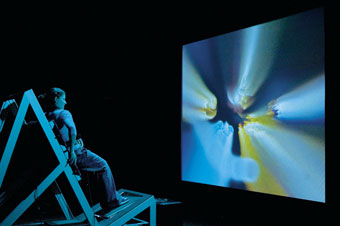The ecology of interaction
Greg Hooper

transmute collective, Intimate Transactions (2005)
photo David McLeod
transmute collective, Intimate Transactions (2005)
Up at the desk, hands to the keyboard, slump and slouch, the arse creeps forward on the chair as gravity takes over. The brain-in-the-vat signals to the peripheral effectors–I choose to press that keypad now. Intimate Transactions drops the periphery as our only extension into the world and brings back the back, the trunk, the torso, as the core embodiment within new media experience.
Intimate Transactions comes from transmute collective, directed by Keith Armstrong with Lisa O’Neill, Guy Webster, and numerous advisors, designers, programmers, fabricators, industry bigwigs and funding bodies. It continues Armstrong’s development of ecosophical praxis, used here as a pragmatic philosophical take on new media production that chucks out the techno-fetish and puts in a fusion of ecological theory and ethics. New media as experience design rather than commodity production. The pragmatic upshot of Armstrong’s ethical position is the development of work that requires prototyping, interviews with people about their experience of the work, and further prototyping. Perhaps that is the contribution of new media: the introduction of user testing in the arts.
But there is still plenty of tech in the work–sensors to transduce pressure and motion, realtime graphics, immersive sound, lots of grunt at the server. And it’s running across GrangeNet, a high-speed research network down the east coast that is a million times faster than the old 56k modem. A 2-week download on the modem or a day or so on ADSL is one second on GrangeNet.
I got to play with Intimate Transactions at the Block, one of the exhibition spaces at QUT’s Creative Industries Precinct. The room is dark and smallish, set up to give that distractionless isolation ward experience that signals new media installation. There’s a bunch of equipment: speakers all about, projection wall in front, strange apparatus in the middle. The strange apparatus is the Bodyshelf, an almost vertical backrest with a shelf to rest the feet on. Physiotherapy meets high-tech correctional facility.
The Bodyshelf is designed and built for Intimate Transactions, and is central to placing the body at the core of the work. You stand on the shelf and lean against the padded backrest. There are sensors to detect the pressure of your body. Padding is adjusted so that the sensors line up right. There’s some training before the work begins, moving the back about to activate the sensors or shifting weight on the feet to wobble the footrest and drive the system that way. I put on a harness with a rubber suction pad that plops onto my stomach. Later on it will vibrate but I won’t notice.
The apparatus is not for individual use: down at Melbourne’s ACMI someone is using another Bodyshelf to enter Intimate Transactions at the same time. We will be in the work together, each of us knowing what the other is doing. This is one of the smart bits of the design because we infer so much about others from their movement–maybe seeing them walk, maybe just the sound of breathing, or maybe the glimpse of shadows moving across a wall. Even though we are both going to use a completely novel interface we can each see the impact on the system of what the other is doing, and so infer each other’s motivation. That builds community, the intimate knowledge of people whose behaviour is more predictable than the behaviour of strangers.
So the whole system forms an ecology and we have avatars within the system: jellybaby angels or glowing discs floating submerged in a dark ocean. The graphics move slowly as we shift our weight on the footrest, roll sidewards across the Bodyshelf, curl and unfurl our backs. Navigating the virtual. No hands.
Most times the action is solitary; I go into one of the system spaces and look around. The space is 2D, translucent creatures float and dart around the edges. Sounds move about, creepy and comfortable. The goal is to hover over one of the creatures, get intimate and be transported into another space, the place of the creatures’ treasure: skeletal, x-ray fragments that rotate and fluoresce around the perimeter. Get intimate again and the treasure is mine, collected at the centre of the projection. I can take all the stuff from all the creatures but the underlying maths of computational ecology change the system if I get too greedy. The creatures become reluctant to share. The treasures can be returned if we co-operate–Brisbane to Melbourne–a little intimate snuggling in the submerged world.
I realise I’ve spent way too long exploring and just soaking up sensation. I start to chase my colleague around the screen. I get off centre and lose my place on the bodyshelf. It doesn’t work right. I think about my position, where I am, how my body moves. I make adjustments, make mistakes, start again, reorientate. There are rules. Predictions can be made, actions calibrated, then it’s over–just 20 minutes of participation which is way too little. Or maybe 20 minutes is just right and I should do this more often, get to know the system better, build up a relationship.
Intimate Transactions isn’t a game, there is no sense of moving to an outcome or nearing the end. It’s a piece of experience design, an opportunity to enter a world like ours but different. I left excited, alert, and without immediate memory–inside the work the experience was too engaging to allow for the hiving off a little bit of brain to run an analytic commentary for later.
Intimate Transactions has been awarded an Honorable Mention in competition at the forthcoming Ars Electronica 2005, Linz, Austria.
Intimate Transactions, transmute collective; director Keith Armstrong; choreographer/performer Lisa O’Neill; musician/sound artist Guy Webster; furniture designer Zeljko Markov; networked between QUT Creative Industries Precinct, Brisbane and ACMI, Melbourne; April 28-May
RealTime issue #67 June-July 2005 pg. 26






